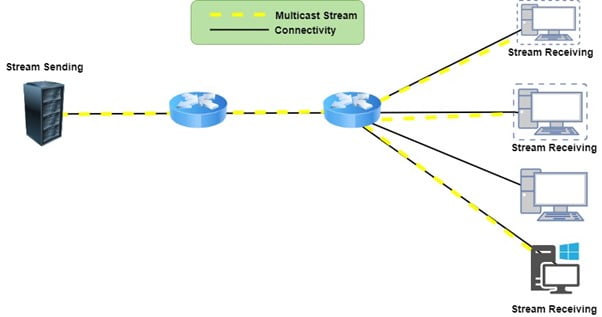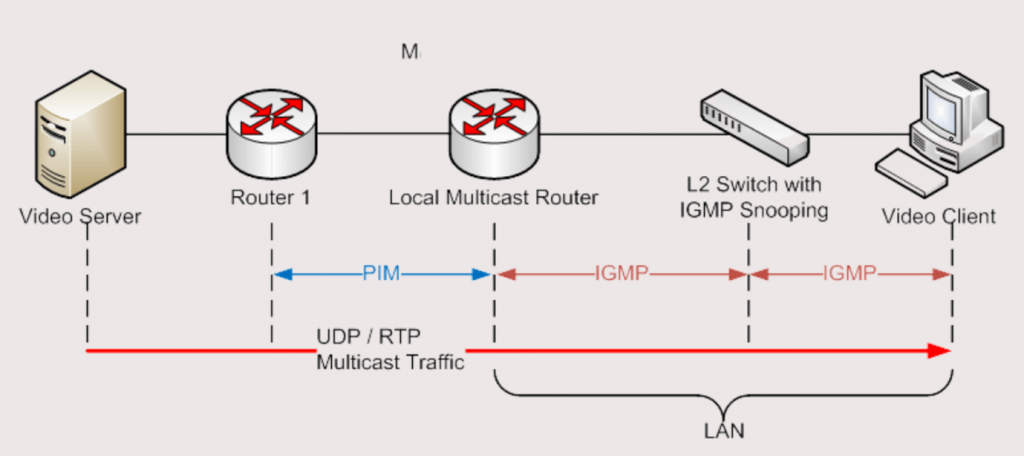Explaining the PIM-Dense Mode in Multicast and its Terminologies.

Multicast is the combination of Multi and Cast. Multi means more than one and cast means streaming data (Packets) from the Source to Destination. PIM stands for Protocol Independent Multicast; this is one of the types of multicasts. In this blog, we will understand the basics of Multicasting with PIM with (DM)Dense Mode, and cover the below-mentioned points-
- Types of Multicasts
- PIM Protocol & Types
- Dense Mode Terminology
- Conclusion
For Sparse mode, Sparse-Dense mode, and best uses we will continue to learn in the next blog.
Types of Multicasts
IGMP (Internet Group Management Protocol) – This protocol uses to communicate (Informed) the Local router that the locally connected user wants to join the multicast streaming traffic. There are three version of IGMP, IGMP Version-1, IGMP Version-2 & IGMP version-3.
PIM (Protocol Independent Multicast)- PIM is the open standard Multicast Routing Protocol as mentioned in the name independent, showing there is not any specific dependency of the routing protocol to configure. This protocol works on Layer-3.
MOSPF (Multicast Open Shortest Path First)- With the name showing OSPF in this Multicast routing protocol there is a dependency of using OSPF, without using OSPF in the backend it will not configurable.
DVMRP (Distance Vector Multicast Routing Protocol)- This routing protocol only supports Distance Vector Routing protocols like RIP & EIGRP. So, to use this Multicast routing protocol we need only Distance Vector routing protocol, this is the limitation of this protocol.
PIM Protocol and Types

PIM is an open standard protocol, some of the terminologies are mentioned below.
- PIM works on Layer-3
- PIM uses multicast address 224.0.0.13.
- PIM uses port no 103.
- Hello Times, is 30 Sec and Hold timer is 105 Sec.
PIM-Dense Mode Terminology
Dense mode is the second type of PIM, which makes the source base tree it is flooding the traffic on all PIM enables routers link. In this mode, the routing table makes S, G (Source, Group) entry in the m-routing table.
Message Types
Hello- Hello message used to discover the PIM neighbor. All routers who are part of the PIM multicast will send the hello message every 30 Sec on multicast IP 224.0.0.13.
Join/Prune- Join message used to join the PIM neighbors and Prune message used to avoid receive the multicast stream, maybe not any user are there to receive the multicast stream that’s why sending this Prune Message.
Graft- Graft message sends by a multicast router which sends only when a new user wants to join the multicast stream. A new user will send an IGMP message to the Multicast router which multicast group they want to join.
Graft Ack- Graft Acknowledge message sent by user connected multicast router which was requested for Graft message to multicast stream router.
Assert – Assert Message is sent only when a router has multiple LAN downstream links with the valid state, at that time duplicity can occur, to prevent is both* routers from sending the Assert message to elect for forwarding the packets.
Interface Types
IIL Interface (Ingoing Interface List)- This interface is the interface receiving the multicast.
OIL Interface (Outgoing Interface List)-This interface is forwarding the multicast traffic.
PIM-DM uses a source base tree and for work on flood behaviour and every time make new S, G entry which is a problem. So unnecessary to send the traffic to all PIM neighbors. Mostly PIM-DM is not most commonly used due to some disadvantages. PIM-SM (Sparse Mode) is used commonly. For details in PIM Sparse mode kindly refer to the next blog. You can get in touch with us for the technology needs for your organization, you can WhatsApp us on +91 9773973971.
Author
Brijesh Yadav
Network Consultant Engineer
